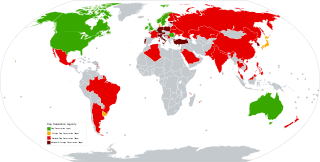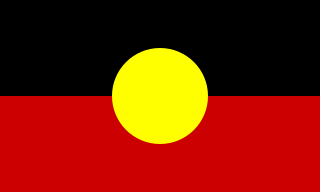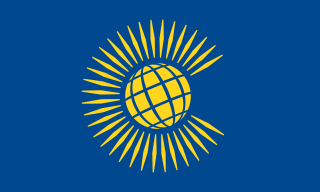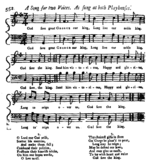
"Lupang Hinirang", originally titled in Spanish as "Marcha Nacional Filipina", and commonly and informally known by its incipit "Bayang Magiliw", is the national anthem of the Philippines. Its music was composed in 1898 by Julián Felipe, and the lyrics were adopted from the Spanish poem "Filipinas", written by José Palma in 1899.

The only official flag for Northern Ireland is the Union Flag or Union Jack, the flag of the United Kingdom; there is no official local flag that represents only Northern Ireland. The flying of various flags in Northern Ireland is a significant sectarian issue, with different communities identifying with different flags.

The flag of Singapore was adopted in 1959, the year Singapore became self-governing within the British Empire. It remained the national flag upon the country's independence from Malaysia on 9 August 1965. The design is a horizontal bicolour of red above white, overlaid in the canton by a white crescent moon facing a pentagon of five small white five-pointed stars. The elements of the flag denote a young nation on the ascendant, universal brotherhood and equality, and national ideals.

The national flag of Malaysia, also known as the Stripes of Glory, is composed of a field of 14 alternating red and white stripes along the fly and a blue canton bearing a crescent and a 14-point star known as the Bintang Persekutuan. The 14 stripes, of equal width, represent the equal status in the federation of the 13 member states and the federal territories, while the 14 points of the star represent the unity among these entities. The crescent represents Islam, the country's state religion; the blue canton symbolises the unity of the Malaysian people; the yellow of the star and crescent is the royal colour of the Malay rulers. It is in the stars and stripes family of flags.

The coat of arms of Australia, officially the Commonwealth Coat of Arms, is a formal symbol of the Commonwealth of Australia. It depicts a shield, containing symbols of Australia's six states, and is held up by native Australian animals, the kangaroo and the emu. The seven-pointed Commonwealth Star surmounting the crest also represents the states and territories, while golden wattle, the national floral emblem, appears below the shield.

Flag desecration is the desecration of a flag, violation of flag protocol, or various acts that intentionally destroy, damage, or mutilate a flag in public. In the case of a national flag, such action is often intended to make a political point against a country or its policies. Some countries have laws against methods of destruction or forbidding particular uses ; such laws may distinguish between the desecration of the country's own national flag and the desecration of flags of other countries. Some countries have also banned the desecration of all types of flags from inside the country to other country flags.

The Australian Aboriginal flag is the official flag of Aboriginal Australians. It was granted official status in 1995 under the Flags Act 1953, together with the Torres Strait Islander flag, in recognition of their status as Indigenous peoples of Australia. The two flags are often flown together with the Australian national flag.

The flag of the Commonwealth of Nations is the official flag used by and representing the Commonwealth of Nations. Its current design dates to 2013, a modification of a design adopted in 1976.

The monarchy of Australia is a key component of Australia's form of government, embodied by the Australian sovereign and head of state. The Australian monarchy is a constitutional one, modelled on the Westminster system of parliamentary government, while incorporating features unique to the constitution of Australia.

The flag of Australia is based on the British Blue Ensign—a blue field with the Union Jack in the upper hoist quarter—augmented with a large white seven-pointed star and a representation of the Southern Cross constellation, made up of five white stars. Australia also has a number of other official flags representing its people and government bodies.

Canadian royal symbols are the visual and auditory identifiers of the Canadian monarchy, including the viceroys, in the country's federal and provincial jurisdictions. These may specifically distinguish organizations that derive their authority from the Crown, establishments with royal associations, or merely be ways of expressing loyal or patriotic sentiment.
The Medal for Gallantry(MG) is a military decoration awarded to personnel of the Australian Defence Force. It recognises acts of gallantry in action in hazardous circumstances. The MG was introduced on 15 January 1991, replacing the Imperial equivalent. It is ranked third in the Gallantry Decorations in the Australian Honours System. Recipients of the Medal of Gallantry are entitled to use the post-nominal letters "MG".
The symbols of Queensland represent the Australian state of Queensland and the Queensland Government. The different symbols and emblems represent both the state and the government. The official state emblems of Queensland are prescribed in the Emblems of Queensland Act 2005.

The Australian flag debate is a question over whether the Australian flag should be changed, particularly to remove the Union Jack from the canton, but also to possibly introduce a completely new design without the Southern Cross. Acknowledgement of the significance of the issues, and corresponding changes are required to reflect Australia's multicultural society, as well as to reflect Australia's immensely rich, and intricate and complex shared history.

The Commonwealth of Nations, often simply referred to as the Commonwealth, is an international association of 56 member states, the vast majority of which are former territories of the British Empire from which it developed. They are connected through their use of the English language and historical-cultural ties. The chief institutions of the organisation are the Commonwealth Secretariat, which focuses on intergovernmental aspects, and the Commonwealth Foundation, which focuses on non-governmental relations among member states. Numerous organisations are associated with and operate within the Commonwealth.

The Australian government debt is the amount owed by the Australian federal government. The Australian Office of Financial Management, which is part of the Treasury Portfolio, is the agency which manages the government debt and does all the borrowing on behalf of the Australian government. Australian government borrowings are subject to limits and regulation by the Loan Council, unless the borrowing is for defence purposes or is a 'temporary' borrowing. Government debt and borrowings have national macroeconomic implications, and are also used as one of the tools available to the national government in the macroeconomic management of the national economy, enabling the government to create or dampen liquidity in financial markets, with flow on effects on the wider economy.



















